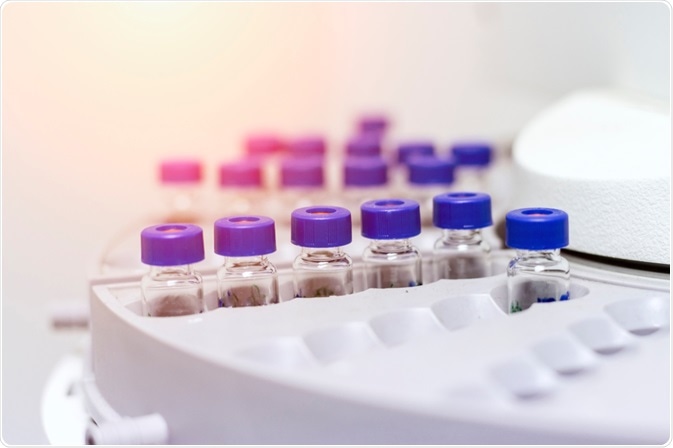Chromatography is a well-established method of separating components of a mixture. A wide range of industries rely on chromatography for several applications.

Image Credit: Ropisme/Shutterstock.com
While the technique is effective and cost-effective, it poses a significant threat to the environment and people due to the harsh chemicals it uses and large amounts of energy required, both factors that are known to be detrimental to the environment. Because of this, scientists have focussed efforts on developing the chromatography process so that its associated risks are reduced. The idea of ‘green chromatography’ has emerged, which aims to evolve the chromatography method to make it more sustainable and eco-friendly.
The impact of chromatography on the environment
The use of organic solvents in chromatography is one of the most toxic parts of the process. Solvents present a threat to the environment and human health. The use of them in chromatography puts those who work with the chemicals at risk of exposure. In addition, the environment is threatened by chemical leaks either by accidents or via the slow accumulation of toxins into the nearby environment.
Chromatography also requires the use of fume hoods due to the toxic nature of the solvents used in the mobile phase. While the fume hoods prevent those working with the chemicals from exposure, they rely on huge amounts of energy. Evidence suggests that buildings with fume hoods use four to five times more energy than comparable buildings without hoods. Usually, this energy comes from nonrenewable sources, making buildings that use fume hoods detrimental to the environment and a source of greenhouse gases.
Finally, chromatography can release toxic material uncontrollably into the surrounding environment, putting those working with the method and the nearby ecosystems under threat.
Moving towards sustainable chromatography
To mitigate the various threats to the environment and human health related to the use of chromatography, scientists have developed the technique so that non-toxic agents replace toxic ones where possible and energy consumption is reduced and sourced from renewable supplies. Here, we discuss the major alternations to chromatography that make the process ‘green’.
Switching toxic solvents to non-toxic alternatives
Tackling the use of toxic solvents is the main focus of green chromatography. Much research has been conducted to discover which non-toxic solvents can be used to replace toxic ones without reducing the efficacy of the process.
The most commonly used solvent in chromatography is acetonitrile, a volatile organic compound. Studies have shown that a mixture of propylene carbonate–ethanol-water can be used to replace this toxic solvent, resulting in comparable levels of efficacy. Other studies have shown that an ethyl acetate–ethanol mixture can also be used as a more eco-friendly substitute for acetonitrile.
Other alternative non-toxic solvents have been established to replace other toxic substances. Solutions of 0.04% triethylamine in water are an effective alternative, for example. Ethanol, ethyl acetate, or even water has also commonly been used throughout the literature.
Scientists have developed solvent selection guides to help users of chromatography select appropriate non-toxic alternatives to traditional toxic solvents. As research continues, these guides will grow, and the adoption of ‘green chromatography’ will become more feasible across industries.
Making sample preparation greener
Preparing samples for use in chromatography is the phase that is the most damaging to the environment. Green chromatography aims to update this part of the method so that it is more environmentally friendly.
Firstly, it is advised that those using chromatography should first always consider is sample preparation is necessary. In most cases it is, however, in certain cases it can be skipped. For the majority of cases that require sample preparation, scientists have established updated protocols that reduce the environmental impact of the process. Studies have shown that simple matrices such as alcoholic beverages, petroleum products, and even water can be used instead of the chemicals usually required in this stage.
In recent years, one alternative method, in particular, has emerged as a popular and effective ‘green’ solution to the environmentally threatening traditional method of sample preparation. Dispersive liquid-liquid microextraction (DLLME) is an alternative method that uses a small amount of a nonpolar solvent mixed with roughly 1 ml of a less toxic dispersive solvent. Ultrasound is sometimes used to assist this method, eliminating the requirement for a disperser solvent.
The future of chromatography
Much research has been conducted in research years to help establish greener methods of chromatography. Many alternatives to toxic solvents have already been identified with more likely to emerge in the coming years. It is predicted that as work in this area continues, the chromatography process will become more environmentally friendly and less risky to those who work with it.
Eventually, numerous solutions will need to be adopted in unison to fully realize the meaning of ‘green chromatography’. For example, alternative non-toxic solvents will need to be used alongside renewable energy sources.
Sources:
- Developments in Green Chromatography. Marek Tobiszewski, Jacek Namiesnik. LCGC. Available at: www.chromatographyonline.com/view/developments-green-chromatography
- Płotka, J., Tobiszewski, M., Sulej, A., Kupska, M., Górecki, T. and Namieśnik, J., 2013. Green chromatography. Journal of Chromatography A, 1307, pp.1-20. https://pubmed.ncbi.nlm.nih.gov/23932374/
- The green fields of chromatography. Sarah A. Webb. Future Science. Available at: https://www.future-science.com/doi/full/10.2144/000114235
Further Reading